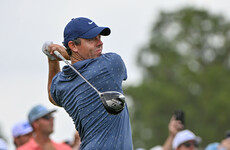LAST MONTH, WE outlined the process involved when a professional rugby player suffers a suspected concussion.
To underline the point that the actions described in that piece are for the elite game rather than amateur and domestic version of the sport here are the protocols the IRFU has in place for the treatment of players at junior and amateur grades, under the ‘domestic’ umbrella.
The union has produced a range of videos for people involved in rugby at any level. The specifically targeted videos are available through links below, but the most comprehensive information is contained in this clip.
Though aimed at coaches, it is important to understand the responsibilities involved in taking care of a player with suspected concussion.
In the video, Dr Rod McLoughlin explains concussion, its signs and symptoms, before the return to play protocols are outlined.
Symptoms are more difficult identify and range from things such as unusual anxiety, aggressiveness to drowsiness, confusion and forgetfulness. However, the symptoms fall into four main categories which McLoughlin explains in depth from 3.00 in the above video.
When signs or symptoms are suspected by player, coach or referee, the first part of the IRFU’s Stop Inform Rest Return process is brought in to play.
1. Stop
- Stop a player from continuing to play
- If a spinal injury is suspected, don’t move the player, call the emergency services.
- If safe to move a player, remove them from the field and do not allow them to return.
- Assign the player to a person of responsibility — i.e a coach, medic or family member.
- Player must not be left alone or allowed to drive.
2. Inform
- Inform the person responsible for the player’s care about the suspected concussion.
- Explain how it happened.
- Inform them that the player should be monitored and medically assessed.
- Advise them of the graduated return to play protocols (GRTP, explained below).
3. Rest
- Players must not train or play any sport or physical activity for a minimum of 14 days
- Player should avoid use of mobile phones, computers and video games until symptom free.
4. Return
- Players should get medical clearance before they are ready to return to play.
- Coaches must ensure the player has followed the GRTP.
Amateur Return to Play Protocols
Unlike the professional level protocols where players are constantly under medical supervision and can complete protocols within a week, the domestic branch of the IRFU stipulate a minimum 21-day layoff for a concussed player or 23 days for all junior levels.
- Rest, no physical activity (14 days)
- Light aerobic exercise (1-2 days)
- Rugby specific exercises (1-2 days)
- Non-contact training drills (1-2 days)
- Contact training after medical clearance (2 days)
- Return to play (1 day)
The elite level and domestic game protocols overlap, but only after two weeks of enforced rest. Once a player comes through that first stage symptom free, they may progress to the next stage and the same requirement exists for the remaining five stages.
For non-coaching participants in domestic rugby, click on the link that applies to you below – the refereeing information is also important to be aware of.














Fantastic article, should be sent to every club, school and parent( if the kids play rugby or sports obviously) in the country. Could save kids life some day.